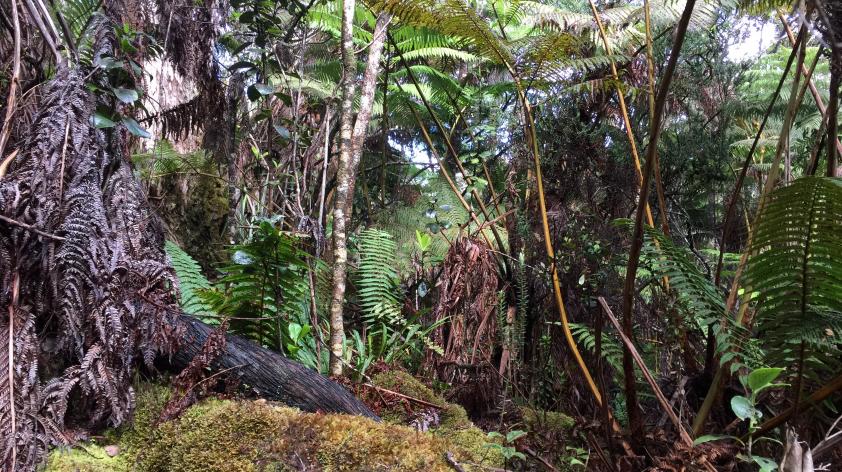
Monitoring the newly released ‘Alalā
The pre-dawn alarm rouses the morning field team. The stars are still out, which means the ‘Alalā are still sleeping. After a quick breakfast guided by head lamp, we prepare for the day ahead.
Every step of what we are doing has been methodically planned and practiced. Yet, there is still a sense of trepidation in the air because we hope the birds will be where we saw them roost the night before. We eagerly put together our packs with our field gear and radio receivers, heading out the door and into the crisp air.
As we walk towards the release site in the dark, the morning team pauses and takes a quick read on the birds’ locations. The reassuring “beep, beep” from the receiver for each birds’ frequency is a welcome sound. One of us slips on a black costume and proceeds towards the release aviary. The costume helps prevent the birds from making associations between people and food, and has been used in all positive human contact since the birds hatched 16-17 months ago. While the costume has thus far been effective—the ‘Alalā do not seek out humans for food—it is still hard after all of these months to not be momentarily thrown off by the presence of a grim reaper figure in the dark. Those of us left behind in the forest begin to hear the stirring of the birds as their calls drift through the branches of the ohia and koa trees with the dawn light creeping above the horizon.
The costumed team member heads into the hidden corridor of the aviary that had previously housed the six free-flying birds. It currently holds the next group waiting to go out in a couple weeks’ time. Whoever is on aviary duty that morning will fill up the food hoppers that stand in and around the aviary, and will monitor the birds’ activities for the next 7-8 hours. Just as it gets light enough to see the birds’ color bands, one by one the six newly released ‘Alalā come down to feed from the hoppers.
The team member left in the forest stays hidden among the dense understory, waiting for birds to venture beyond the vicinity of the aviary. If they are lucky they will catch a glimpse of foraging behavior or social interactions between the newly released birds. All the while the chatter of ‘Alalā contact calls ebb and flow throughout the day, punctuated by the occasional alarm call. As they explore their new home, we collect data on their health, movement, foraging and social behavior to help us better adapt our management practices in real time and learn for future releases.
Seeing them all alive and well in the wild is indescribable. Each bird has a personality and a Hawaiian name. For example, Awa, whose name literally means mist, fog or smoke of the mountains is a bird who tends to be quieter, less dominant, but always present. The field team and conservation breeding staff have known each individual since they were an egg, and have spent countless hours observing them in secret. We care deeply about each one, yet, they do not know us by face or name. Nor do they know that each one of them holds historical potential for their species.
Reintroductions are a risky business. Released animals face predators, unknown landscapes and patchy food resources. While the ‘Alalā will encounter many challenges ahead, they are as prepared as possible. The birds have been trained to recognize their main predator, the ‘io (Hawaiian hawk), and to identify and consume a number of native fruits and berries. They have been released into one of the few remaining tracts of pristine Hawaiian forest. The release plans and monitoring objectives were determined through months of preparation and extensive discussion between the multiple stakeholders of the species’ working group.
The ‘Alalā make up part of the fabric of Hawaii island’s ecological uniqueness and cultural heritage. The stakes are high and we have done the best possible to prepare. No doubt there are still lessons to be learned, but for now it’s up to the birds.













